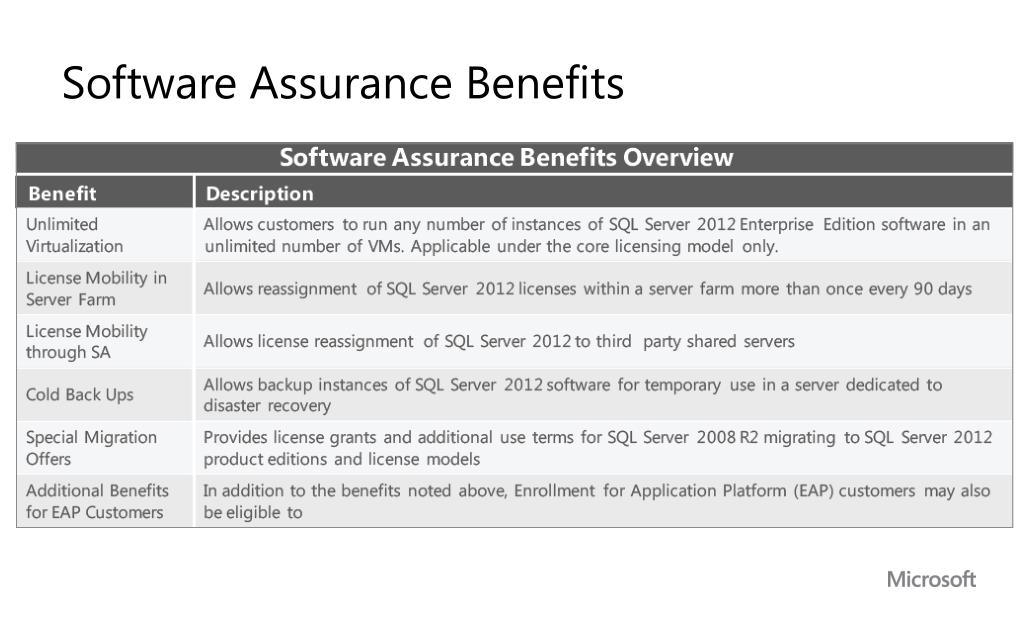
- SQL SOFTWARE ASSURANCE BENEFITS HOW TO
- SQL SOFTWARE ASSURANCE BENEFITS LICENSE
- SQL SOFTWARE ASSURANCE BENEFITS FREE
With SA, disaster recovery (D/R) can now be tested once every 90 days with the D/R VMs live for a brief amount of time. Without SA, you must pay for all HA and D/R replicas in an AG configuration. This new SQL Server 2019 benefit applies to any release if the cores are covered with SA. Those tasks are no longer considered active use. With Enterprise Edition, secondary replicas in an AG can be used for DBCCs, seeding log shipping, and generating backups without requiring a license. Microsoft relaxed the rules for availability in two other ways. That example would be considered invalid.
SQL SOFTWARE ASSURANCE BENEFITS FREE
If the primary has 56 cores, you cannot split that up and apply 28 to the one free D/R host covered by SA and 28 to another D/R host elsewhere in the topology. There is also the case of partial licensing. The primary host would need 8 more cores of licensing. For example, the primary host has 56 cores and D/R has 64. If the D/R server has more cores, you need to have the same number of cores licensed on the primary. One caveat: if you are choosing per-host licensing, the primary and D/R hosts can have the same or less cores. For more examples, see the Channel 9 videos and blog linked in “For More Information”. Without SA, all three would require a license. If you do not, each VM running SQL Server requires a license.įor example, if you have three replicas (one primary, two secondary) in an Always On Availability Group (AG) configuration, the primary which has the read/write copy of the database needs a license, but the two secondary replicas would not if you have SA.

This benefit is only valid if you have SA.
SQL SOFTWARE ASSURANCE BENEFITS LICENSE
For in-guest based availability solutions using SQL Server features, Microsoft no longer requires a license for servers that are considered passive, or not running an active SQL Server workload. One of the biggest changes Microsoft made to licensing SQL Server with SQL Server 2019 is around availability. It is recommended that when licensing per host, you have a method (log, document, etc.) to keep track of vMotion and when VMs are started/stopped to prove compliance if necessary. Availability is discussed in the next section. However, if that VM is part of an availability architecture, it may be accounted for. If a VM running SQL Server on a fully licensed host is moved to another ESXi host that does not have enough SQL Server cores licensed (or is not licensed at the host level at all), you will need to acquire the proper licensing for that VM to run on that other host. For both host-based scenarios, just because you can deploy many VMs on a single virtualization host does not mean you should as performance could potentially suffer in guest. This means you can deploy as many VMs with SQL Server as you want on a single ESXi host. SA adds the additional benefit of unlimited virtualization when licensing per host. If a 57 th VM is created, additional core-based licenses are required. This means you can run up to 56 VMs with SQL Server on a single host. For host-based licensing, Microsoft counts VMs that are running SQL Server. When licensing per host, if you use Enterprise Edition without SA and the server has 56 cores, you get 56 core licenses. If you do not want to pay for a core, it physically cannot exist in the server. If licensing per host, Microsoft does not care if you disable cores all cores must be licensed. When a license is purchased for an entire ESXi host, you license all cores.
SQL SOFTWARE ASSURANCE BENEFITS HOW TO
An example of how to configure a “must” enforcement in DRS is shown below.

DRS affinity rules allow you to designate specific hosts for VMs running SQL Server within an ESXi cluster that runs other workloads besides SQL Server. This assumes that the VMs are running on dedicated hosts in an ESXi cluster that may or may not be dedicated just for SQL Server. If you deploy quite a bit of VMs with SQL Server, it may make sense if you add up the per VM licensing to see if it would be better to license the hypervisor host(s). It may be simpler and effective to license the whole host. If you use very large VMs with SQL Server inside, they are often the only thing running on the ESXi host. Even if you are using a lot of Standard Edition, it may make more sense to license hosts using Enterprise. There are two main scenarios: very large VMs and many SQL Server VMs. Licensing a virtualization host is only possible with Enterprise Edition. Licensing an ESXi HostĪt some point, licensing is a combination of a math problem, the underlying architecture, and how you want to pay for SQL Server.

In this blog post, you will learn about licensing an entire ESXi host, how availability affects licensing, and more about Software Assurance. Part One laid the foundation of SQL Server licensing. Welcome to the second, and final, installment of this blog series.


 0 kommentar(er)
0 kommentar(er)
